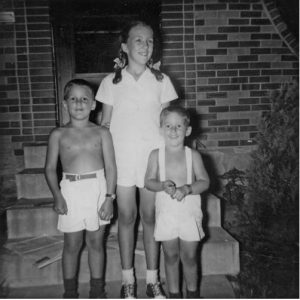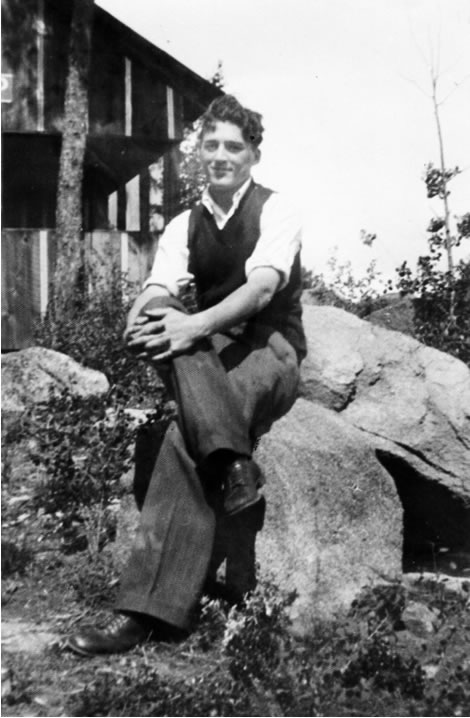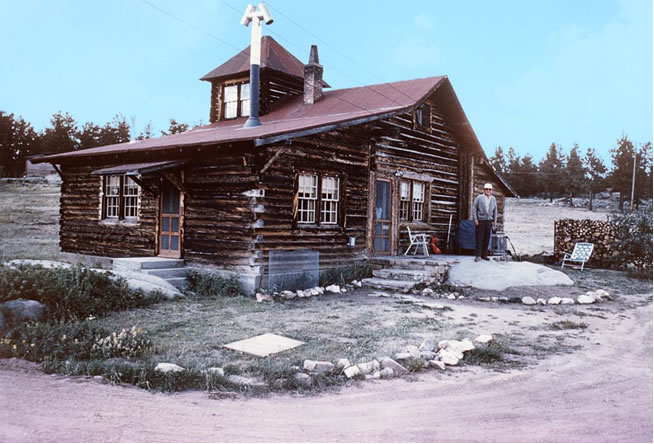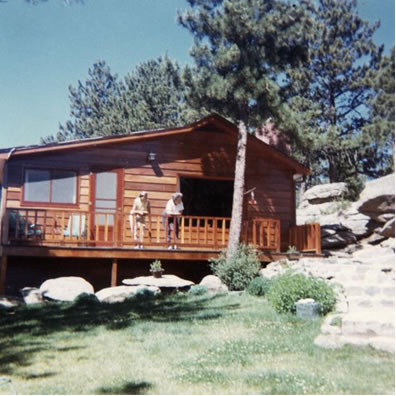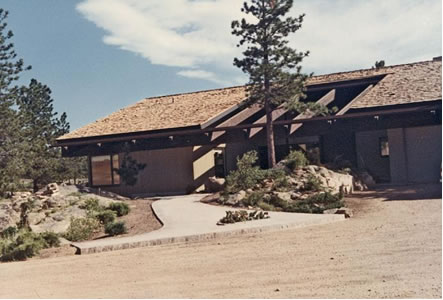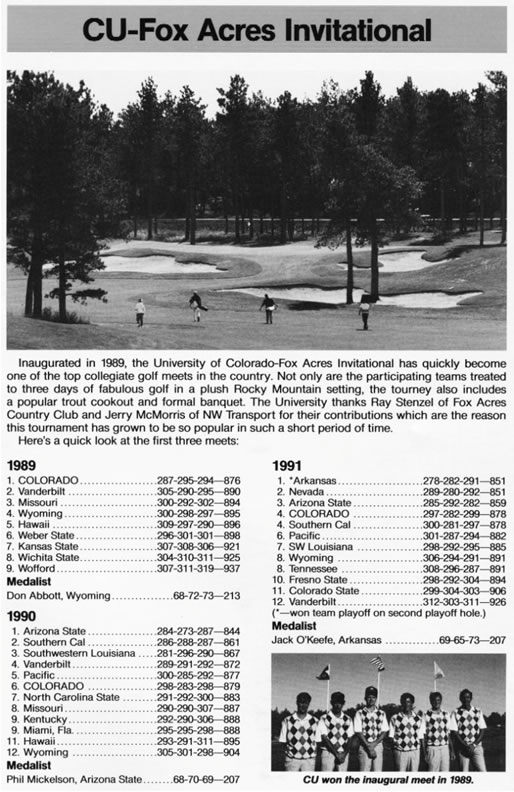Interview with John Stenzel and Judith Liebman
August 16, 2013 at Fox Acres
Red Feather Lakes, Colorado
Interview and transcription by Linda Bell
[Interview and Addendum available as PDF files]
See also related history: The Story of Fox Acres – 1978 article from the Boulder Daily Camera, by Robert C. Looney
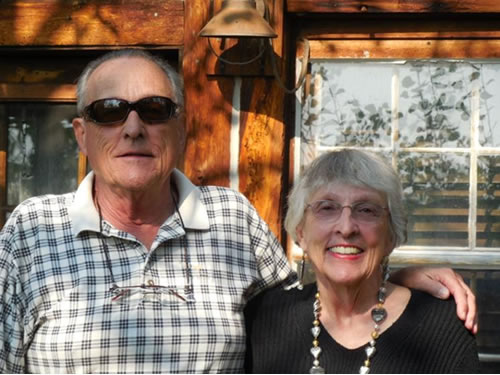
Table of Contents:
- Car Tour around Fox Acres/ Evolution of a Golf Course
- Interview continues at Liebman Home/ Evolution of a Golf Course
- Background of the Galloup Family in Red Feather Lakes
- Personal Memories of Summers in Red Feather Lakes
- The Stenzel Siblings Move On – Judith, John and Bill
- Addendum: From the family photo albums
The Evolution of a Golf Course
Judith: On the Fox House, we (came) out to stay after our older son was born in April and we brought him out that following summer and stayed in the Fox House. (My husband) Jon was writing his PhD dissertation and there is a cupola in the Fox House where the manager used to keep an eye on the foxes. There weren’t foxes at that time, but this is the venue. The cupola was still there. Jon set up a desk and we had purchased a Selectric typewriter, so he typed up his PhD dissertation up there that year. His field is environmental engineering. So that was an interesting place to do that.
Dad (Ray Stenzel) was in the midst of getting landscaping and getting more lakes done. The first lake was done, the one we just passed. There wasn’t enough natural fish food yet so he had this stuff called “trout chow” which looked like dog chow and we would go out and scatter that. The kids remember that, so that went on for several years when the kids started getting older.
John: The Fox House and this little cabin up here we call “Sunning Rock,” those were the two. Now that has been remodeled three times. It was full of pack rats and there was stuff all over. My dad and two of my cousins went over and kind of cleaned it out so they could create a living space. They stayed in the Fox House. We did the Fox House first to make it livable.
Judith: For the next years when we came out we would stay here (in the Fox House). It was a real estate office for a while and then they turned it into a spa.
John: Judith, I’m going to interrupt you here. It might be better to have some chronological order as we’re going along. The first two pieces of property in the Fox Farm were about 37 and a half acres and it was owned by the Blincows. That was the family, the last family to have the foxes.
I remember coming down here when I was a youngster, back in the mid to late-`40s. They still had foxes at that time and the pens were sitting out to the southwest. (The Blincows) would go up into the cupola when the foxes were mating because the female would attempt to run the male off so it didn’t really work very well. That was the main reason the cupola was built. I remember, I came over here as a youngster maybe twice and can remember seeing the foxes in the pens.
The family was from Kansas City, but I was born in Denver; Judith was born in Denver, and Bill too. Then we moved to Kansas City right after Bill was born in `42. My mom’s parents built a cabin (in Red Feather Lakes) just above Hill Top. It was called “Young’s” at that time. My mother and her two sisters shared that cabin, shared it as a family. And that’s kind of the impetus of what happened here.
In the fall of 1959 I was in school at Westminster College in Fulton, Missouri, and we were sitting down to have dinner at the fraternity house and the phone rang. The house mother came in and said, “John, your dad’s on the phone.” I thought “oh no” it must be serious because dad never called. So I went to the phone and answered and he said, “Say John, I just wanted to know what you think. We’ve just returned from over-viewing the fox farm with Jack and Jerry Dalton ….” They must have had the listing and knew that dad might have interest in the property , because it was getting pretty tight in that little cabin up there with the three families trying to share it, and find times to share it. Dad had even built a bunk house to try and expand that a little bit, didn’t he Judith? Not much space though… So anyway, he said, “I just wanted to know what you thought about buying the fox farm and, you know, having something for the family?” I said, “Why are you asking me? But I think it would be terrific.” So I think we ended up closing in January 1960 on the 37and a half acres. So that next summer, dad and mom came out and spent a lot of time cruising the property. He would walk around, see where the water was coming in, where it was going out. He had a minor in geology in college so that interested him a lot. There were several beaver ponds along the area and he started cleaning it up. It was a real mess. There was … the Fox House was a turn-of-the-century structure. I don’t know whether it was late 1800s or early 1900s. There were little fox pens. There were two CCC camp barracks that they used as the long runs and the housing, and they would have the fox pens attached to that. That’s how they fed them. They brought those buildings down (from the CCC Camp) and used those. I don’t really have much historical knowledge about what took place before other than that’s where those two buildings came from. So then dad bought a little red wagon and a tractor and started cleaning it up. He brought my brother and I out for a summer and handed us buckets and magnets and we went around picking up nails and every kind of metal product you could possibly imagine.
Judith: I didn’t have to do that because I was off working in California. I’m four years older than he is.
John: Yea, you got out of that. So we cleaned all that up. Then he came up with an idea. He said, “I’ve got 37 and a half acres here, I’ve got water coming in and going out, I would really like ….” This was going to be kind of a family retreat. He said, “I’d really like two or three golf holes.” He was an outstanding golfer and a great athlete. He said “if I’m going to be up here, I really don’t want to lose my golfing skills so I need to have a hole or two.” So the plan started that he would build one or two or three golf holes. “We’ll just have a little… .”
Judith: But this was after he built his house.
John: Well, no, he actually started on that …. He actually built his house in maybe `67 or `66. I’ve got to think … it could have been `65. But it was five years since he was planning on putting in….
Judith: Oh, I didn’t know that.
John: No, he had planned on that. In the meantime he started on his first golf hole and he decided, well, we’ll put the lake here near my house. So the very first lake is this one out here in front of us. And his house was built right up there above that lake. My step-mother still has that (house). Our step-mother, pardon me… . Phyllis Stenzel is her name. I think she’d be happy to sell it.
Judith: Yes, it’s available.
John: She in her upper 80s at this point in time. Eighty-seven I think. They live in Denver. She spends a little bit of time up here, but not much.
(Break for picture of Fox House)
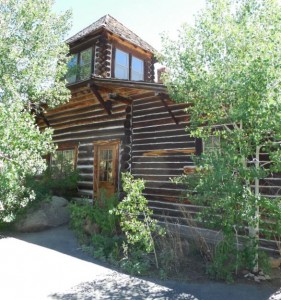
John: A couple of people approached dad to see if he would be interested in buying their property. Property that was contiguous to the original 37 and a half acres. Both (developed and undeveloped properties). Most of it at that time had to do with whether there was a residential unit on it of some kind. So he started buying up these little separate pieces of property.
John: The drainage that fills the lakes and property is from what used to be called Columbine Creek. It was a part-time flow stream so you would get some spring moisture mostly. And then whenever you’d get a winter (with a lot of snow) this is an unbelievable watershed for collecting the water.
John: The house was built in the mid-`60s and I think they built the dam in `65. Don Brandenburger was the architect. No, I’m sorry, this was before Brandenburger. Kivett and Myers was an architect firm from Kansas City that did their house in Kansas City. He used the ranch style.
Those houses that you see right along here, those are the very first houses built here other than dad’s house. And they were built for sale. Then it was no longer a family compound. This came a little bit later. My next point was when we started picking up these additional pieces of property and at that point in time we had two and a half golf holes actually completed. We were probably playing five or six holes per round because we had separate tee boxes going into each green. So adding these other pieces of property, dad’s idea was, “Well you know what? We will just make this an executive golf course. We can add 30 to 40 homes maybe.” So his idea was to make it executive and make it a little more than just a family retreat. He abandoned two of the golf holes that were not quite completed and we ended up keeping hole #3. So that’s the only hole left of the original three. At that time he brought in John Cochran from the Maxwel firm in Denver to help him design the nine-hole golf course.
My mom came here as a child, out of the Greeley-Windsor area. Her dad was a pharmacist. That was the Galloup family. They had their cabin above what was Young’s store, up there on that mound. Overlooking Hiawatha Lake and Eagle Rock. “Eagle Rock” is only known in our family as “eagle rock”. It is where the gnomes are now. We used to climb that and it was quite a challenge then.
Judith: There weren’t any gnomes there then, no gnomes.
John: Now this is one of the properties we bought up. In fact we’ve had this and used it as employee housing. Also used it as family housing. We just sold it a couple of months ago.
Carol, our sister-in-law, our brother Bill’s wife, she is building a home here. That view is to die for. It’s my most favorite view. You could tell better when these trees weren’t so tall. These trees that came along here, they all started because the soil was disturbed. They never would have come up here.
John: On a clear day you can see forever….
As we started buying up these properties and starting a nine-hole golf course, dad was able to get some additional land when he negotiated with the Quaintance family and that was going to make it be able to be a nine-hole golf course. That’s how we were able to make a kind of a fairway on that. At that time then, it was probably close to 80-85 (acres). These are things that came in a little bit later. We needed a place to have a storage for the equipment that was going to maintain the golf course, and for the equipment used to construct the golf course as well. So my father decided we could use one of those barracks buildings down there to use for equipment storage and the other as a golf cart storage area. Once their house was finished, then we turned the Fox House into kind of a little club house. A starting place where people could come in and meet and then go out and play. Then about the late `70s he was able to negotiate more with the Quaintance family and get an additional acreage that comes over on the east side of where we ended up developing the back nine holes. So we had the front nine – I think there were about five holes completed at that time. So we were able to make an agreement with them. Some of the land is on a lease where we have some water storage on the back side. Then some we added on was here. That’s the part of the course where the fox sheds were, so that’s where we built this maintenance facility over here. This is really on the edge (of the property). There is Letitia Lake.
To get and maintain 18 holes, it was going to take more water than we were able to get from a natural source or were able to bring in from Red Feather Storage and Irrigation. We would buy water from them. The Mitchell Ditch runs right above the top of the property here. Whenever they put us on call, we’d come and draw water from there. But we found out we were going to need a little bit more, so then we made an agreement … the Quaintance family had a little piece of property on the edge of the road next to Swansons. Then down in Red Feather, the South Fork of the Lone Pine, we were able to negotiate with the Swansons in putting in a pumping station so that in the springtime we have quite a few water rights but our priority levels are not that high. Generally speaking they are high enough most years that we’re able to bring some water over from the South Fork when the farmers don’t have it on call. The State also, that’s how they fill Dowdy in priority. Most years we’ve been … I can recall maybe only two or three years when we’ve not been able to bring water over. We’ve been blessed by the amount of water we get as snow. You come down here, and you’ll get these 30 or 40 inch snows and the rest of the area will get 20, 24 inches of snow. There’s a climate here, a micro climate that draws the snow. It’s just absolutely amazing. You wonder how that can happen, but it’s just the way Mother Nature operates.
A later addition was the community services building here, but it’s now just administrative offices for the property owners.
The first of the homeowners came in the `80s. It was either `80 or `82 that we sold off our first residence to an outsider. The `80s, there was kind of a hit there, and then the mid-`90s it slowed down a bit, but of course with the … every time you got a recession or oil embargoes, or that sort of thing, things came down and then that last one of 2007, that just absolutely killed us.
John: Along here is the Leticia Lake subdivision. Here’s another piece of property right down here that we bought individually and completely remodeled and added on to, new bedrooms. The people who just bought this, I think maybe the third owners or something like that, they are completely remodeling the inside of it.
Dad did most of (the the project development). I was busy with the wholesale drug business in Kansas City. That was my main job. I wasn’t on site during that time period other than I’d come out, I’d bring my family out, for ten days or two weeks. Then I would come out maybe once or twice other than that, but I wasn’t here on a daily basis until the mid`80s. Then beginning in 1985 I was spending more time with the project. Dad died in 2006. Bill died in 2008, isn’t that right Judith?
Judith: Yes, that’s right. Bill was young when he died.
John: He had emphysema. My mom was the same thing. He just couldn’t quit smoking until it was too late. One of mom’s sisters too. Everybody in the family smoked. With some people it’s extremely addictive. I was able to quit. I had no issue quitting. My mother just couldn’t do it, nor Bill.
John: So this is the back side. This was done beginning in the late `70s. We first opened the golf course, as an 18-hole golf course, in … actually it was a little sooner than that because we opened the club house in 1980. Two of the golf holes, 16 I think and 17, or 15 and 16, weren’t quite finished yet, so we didn’t get those open until 1982. That’s when that back side opened up.
And then we got our PUD, “Planned Unit Development”, that’s county terminology for giving you authority to sell the properties and make a subdivision in 1980.
Now this is where, the edge of this lake down here is pretty much the end of the development. Outside that property is still owned by the Quaintance family and we have a lease on it for water storage. That will remain undeveloped. These houses along the #3 fairway we built as speculation properties and are from the early `80s. Then we built our respective homes, and the units I didn’t point out as we drove out by that small lake on the west end of the property there were the last we developed and they were built in the late `90s and early 2000s. Then the market started fluctuating.
Judith: Here we are at our house and it was built in 1985.
John: We moved into ours in 1989. We stayed in one of the other houses prior to that.
Judith: When we first planned this house we discovered there was no way to get from the front to the back without climbing over rocks, so we had to re-plat.
Interview continues at Liebman home in Fox Acres/
The Evolution of a Golf Course Continued
John: We finally opened the clubhouse in 1980. It’s been extended. It was about half that size, and we built it so that it was expandable. The theory at most of the places was building large clubhouses with extra space and then carrying a heavy load until they sold all the memberships in the club. Dad’s concept was we’ll build it larger when they come. That was his theory. That was 1980. It was in 1982 then when the last two golf holes were finished so we had a full 18. In the meantime, once we got up to 6 golf holes we could actually play 18 holes using 18 tee-boxes for six greens. I would say that was no later than the mid-`70s that we were actually playing 18 holes of golf.
We had some members joining and we had set the fees – the initiation fees and/or golf fees. If you were a member then you weren’t paying golf fees because you were paying your monthly dues. Those were extremely competitive and lower than market rates. That’s just the way my father operated. I tried on many occasions to get him to increase that and let the people pay their fair share of what they were enjoying.
Judith: My father carried them on the financial side.
John: He did.
John: He had a lot of love for the community and the people. He was so proud of that library. Even now, even since his passing, the change and the growth and what (the library) is doing for the community, is …. It’s a great center of gathering and use for the community – it’s just hard to believe what it’s done.
Judith: The Historical Society uses (the library), there are a lot of programs, and the new science education (initiative). Besides just getting books from the library, the library is (a community facility).
When a dedicated library building was built in Red Feather Lakes in 1987, it was dedicated to Mary Stenzel. The plaque reads: In Memory of Mary G. Stenzel, 1912-1985. The later addition, completed in 2005, included a community room which was also named in the family’s honor.
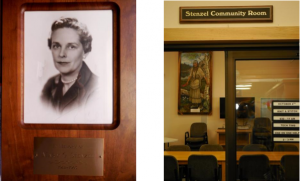
Background of the Galloup Family in Red Feather Lakes
Judith: (The Fox Acres subdivision) isn’t so different from the original scheme in the 1920s. Our grandparents were members of some of the original holes at the golf course. Our mother would take us over there and show us the holes, and heart rock.
John: Our grandfather was a member of the original course because he was a golfer. His name was George Galloup.
Judith: Unfortunately, (his wife) in her late 20s succumbed to schizophrenia and was in a mental institution. And then for a long time and after he died her kids got her out and got her housed in California. Her daughters were the three sisters. But they lost access to their mother early in life. Mary, Georgia and Gladys were the daughters. I can’t even remember her name now.
Jon Liebman: Her name was Flora Blanche Hess
John: I think I remember her being called Blanche. That’s the name that really jumps into my mind now.
Judith: She’s buried in Greeley. They brought her remains back.
John: We never knew her. In those days nobody talked about schizophrenia. It just wasn’t a subject.
Judith: I don’t know if the sisters had grandparents on their mother’s side.
Judith: George built the cabin and bought a membership in the golf club. I think we passed his membership card on to the Historical Society.
Judith and John: He came up (to Red Feather Lakes) in 1922 or 1923. They lived in Greeley.
Judith: Windsor, at that point. This was a summer property. My father and mother honeymooned there. It was likely I was conceived there…. In the old cabin. I am the oldest. Then John. And then Bill.
Personal Memories of Summers in Red Feather Lakes
Judith: When we were kids we’d climb rocks. Go over … the Swansons had horses that needed riding and so we would walk over…. Well, first of all, we had our chores because there was no electricity and no water. Every morning our chores included going down to the town well and bringing up Army 5-gallon cans of water.
John: It was the (Worley well) with the handle pump that’s still there. It was right below us and we’d walk down.
Judith: If we needed a bath we could carry up extra water and heat it up or we could take a bar of Ivory soap and go swimming in Hiawatha Lake, which was cold and could testify that Ivory soap floats! After our chores we’d either go out riding or rock climbing or exploring. We’d go over and get the Swanson horses and we knew how to repair barbed wire fences, so we went in whatever direction we wanted and if there was a barbed wire fence we just cut our way through and repaired it behind us. One time we took a pack trip – not an overnight pack trip, but just some equipment on the horses – up to Bald Mountain. That was an adventure. It was three nights that became four nights and they had the Forest Service looking for us when we came out of Sheep Creek.
John: I’ve got fond memories of this story. I rode “Babe” …
Judith: That was the nag.
John: And supposedly the calmest of the horses. I was not a very well trained equestrian. Horses have always been bigger than me. For some reason they sensed or something that I wasn’t really comfortable around them. So they would take advantage of me. I wasn’t a strong-enough character to try and take control of the horse. Well, this was probably 1953 because I was 13 years old when we did this trip. (Judith) and I and our two cousins – Aunt Gladys’s daughters, Mary Lynn and Georgia Lee, known as Susie, took a pack trip over Bald Mountain and then back down around the side and (came back) down Panhandle Creek. Down to the Sheep Creek area and where the Panhandle burn was. At that time, no one had been in or out of there very much and it was extremely difficult getting through. We didn’t realize how difficult it would be, especially since we left the trail that we should have probably followed. We decided just to follow Panhandle Creek. Well, it took us another extra day or two to get out. Our parents and everybody were in an absolute uproar. They had the Forest Service out looking for us. It was just the four of us. We knew how to feed ourselves and fish, so we got a few fish coming down the creek, we were in plenty good shape. But then we started worrying that they were worrying us about us, `cause we knew we were kind of slow getting out.
One of the things that happened going up over Bald Mountain with this horse – come to find out, something startled it. I thought it was a snake, but all of a sudden my horse bucked up and threw me off and stepped on me. That shook me up quite a bit so I did a lot of walking on this trip. I did some additional riding because it was a long way, but tried to walk as much as I could after that, and I think that was the last time I was on a horse.
We finally got to our first camp site and started taking off the saddle and whatever, and we found out there was a fork sticking out and it poked her. We had mispacked it or something. I was smart to get off and walk because that horse was bigger than me. I’m a very logical individual.
That was one of my very-most memorable things that we did up here, that pack trip, just from the standpoint of camping and taking care of ourselves. We were really independent.
Judith: Our parents … our dad was still back working in Kansas City. He would drive us out for the summer here, and our mother and our aunts were here.
John: Sometimes mom didn’t stay, but we stayed with Georgia or Gladys.
Judith: Mom just gave us complete independence.
John: We look back today and say, “come on, quit this coddling stuff.” Bumps and bruises, so what?
Judith: Remember the time we took the horses over to Lost Lake? There was a dirt road and it cut through. If during a ride we saw an interesting rock pile, we’d tie up the horses and go climb the rock pile and come back down again. We’d be gone all day. We had wonderful freedoms.
John: I never saw a lion until after, shortly after I was married and Jeannine and I were up here. I don’t think it was our honeymoon. I think it might have been a year or two after. We were staying in what we call “Sunning Rock”, that one cabin, and we were staying out there. We’d gone down to Cherokee Park with mom and dad for a fried chicken dinner – at the old dude ranch. A dude ranch that was eventually converted into a bible school.
Judith: At one point it was a dude ranch where you could go for dinner. This was before the Fenders gave us chicken at the (High Country) Lodge.
John: So we were coming back and it was just evening. We dropped mom and dad off at their house and we drove on up to “Sunning Rock”, and we look up and there is this mountain lion walking along just below “Sunning Rock.” “Where’s the camera?” “I don’t have a camera.” “What are we going to do?” “How are we going to get up to our cabin if there’s a lion there?” And so on…
Bears were never a problem back in those days either. I’m talking about when we were kids, though. When we were kids out making all those trips around all by ourselves, we never had that issue.
Judith: I have a bear story. John and I were staying – in fact both families – in what we called “Hidden Valley”.
John: That was that last unit I showed you, and I said that the third family in there was expanding it.
Judith: Our families often tried to coordinate being here together the last two or three weeks in August. So, we’re staying there. That’s was back when I was trying to jog. (My brother) John and I are both really early risers. I get up and I get ready and go out jogging away. He’s reading in the living room, a newspaper or something. I jog and when I was coming back I realized there was a trash can by the door I was going to enter and there was a bear into the trash can. I know John is inside, so I call, “John, John, there’s a bear”. So John comes and looks and instead of trying to rescue me, goes for his camera.
John: I’m a bundle of nerves. It’s the first bear I’ve ever seen up here! And this was in the `70s, probably 1970 I would say, and by the time I got a picture of it, and I got the film processed, got the picture back, here was this little brown dot way off clear across the fairway. I do love you sis, but I wanted a picture of that bear!
Judith: My husband Jon and I have three children, ages 53, 51 and 50. The youngest Michael lives up near Chicago, the oldest Chris is out in California, and our daughter Becky, who is the middle child, lives in San Antonio. Before their kids got into camp and so forth they would come up every summer. And they would also try to coincide vacations, so the cousins would all know each other.
John: But the issue is – there’s a time period in everybody’s life when this place becomes “Dead Feather.” From the time when you are about 13 or 14 until about the time you are 18 or 19.
Judith: That never happened for me.
John: I had really good friends in Kansas City and I loved sports and I had girlfriends and why would I want to be out here when I could …. And once I got old enough, dad was putting me to work. One summer when I was 15 they were able to get rid of me. I was probably the problem child of the three of us. I was more adventuresome. And dad would pick on me rather instead of my brother Bill, because my brother Bill – my brother Bill, every time my dad would ask him to do something that he didn’t want to, (dad would) say, “So all right, go to your room.” Well Bill loved that. He loved reading books. I was so social I couldn’t stand it, so I went back to work. ‘So he loved my brother more than me….’ So I had to go back to Kansas City and see all my friends. I was more social than either Bill or Judith, I think.
Judith: I just loved it out here. It was just in me.
John: We also have three children. We have our oldest daughter Kim who lives in Fort Collins with two granddaughters. We have a son Mike who lives in Fort Collins and works for our family business, Campbell Development, and is not married, and the youngest, Sara, lives outside of Sacramento in the Granite Bay area and she has two daughters, so we have four granddaughters.
****************
John: Mother would take us around and we’d learn more about nature and flowers.
Judith: And the amethyst mine, she would take us to the amethyst mine.
John: And the old uranium mine on Prairie Divide which became a beryllium mine which was near the diamond mining area, which never really panned out. The ghost buildings down in Manhattan, we’d go down there while they were still standing.
John: I think our mother wanted us to experience the same kind of freedoms she had with her sisters. She succeeded.
John: There was a story … I was thinking about. Jeannine told me not to forget it when we go out, be sure to tell you about it. Now I can’t remember.
Judith: While John is thinking, I’ll tell you one of the things we did in the old cabin was play Monopoly by kerosene lamp. My mother taught us her version of Mahjong. She had … when they lived in Denver before they moved to Kansas City … from a friend in Denver she bought this gorgeous Mahjong set for $5. It was ivory and teak and sandalwood. She taught us her version of Mahjong which was kind of like rummy. We would play by kerosene lamp, on the front lawn. “Red Feather Rummy” was our version of Shanghai rummy. We called it “Red Feather Rummy” and we taught our kids and they taught it to their kids.
John: And I think in the community they played Mahjong.
Judith: Yes, I think mom had some Mahjong friends.
John: And “I Doubt It”…
Judith: Oh, I’d forgotten about playing “I Doubt It.”
John: And Susie, for a little snack we were eating Saltine crackers. “Here, try this one,” so she gave it to me. My mouth just exploded. She decided to put a little Tabasco droplet on this cracker. It just blew my mind. My good old friendly cousins.
Judith: Aunt Gladys was a wonderful cook – pastries, pies made in the old wood stove. What she would produce out of that old wood stove was wonderful. Then when they finally got electricity, mother and Aunt Gladys loved coffee. So they had a coffee machine – a “HAVA-JAVA” – in which the water was piped in. You got your water automatically. It was like a “Mr. Coffee” except the water was automatic. You ground your coffee and put it in. She was so proud of HAVA-JAVA. Then, when they did some minor remodeling of the cabin and the tax people, the assessor, had to come, she was standing in front of the HAVA-JAVA so he wouldn’t see it.
John: So, piped in water, ay?
John: The other thing I remember is the hay rack rides on Fridays and we’d go out and do campfires. We’d go out to Bellaire sometimes, and sometimes we’d go over to Dowdy.
Judith: And then the square-dances.
John: Those were at the American Legion Hall. That was over at Dowdy.
Judith: And I remember that we used to be so impressed that there were these cowboys around. I mean, I was a young teenager. I never had … but my cousin Mary Lynn did!
John: And I’ve told you I was one of the more social ones. But I didn’t really have the nerve …. We probably did these hay rack rides and square-dances for about three, four, five years maybe, before they ended. But anyway, the Blincows, who owned the Fox Farm at that point in time had a daughter. I can’t even remember her first name, but she was my first … imaginary girl-friend, or something like that. But I just really thought she was beautiful and I really wanted to ask her to dance at the square-dance. I think the very last year that they had the square-dancing I finally got up the nerve to ask her because this was my last chance. I (danced) “Oh, Johnny, Oh” with her. I wasn’t really that old. I was probably ten. I wasn’t into kissing yet! I just knew she was different.
Judith: And I remember “Little Foot…” In addition to the regular square-dances that they do, there were couple dances in between. One of them was “Put Your Little Foot, Put Your Little Foot Right Here”. Then they had polkas – they had great polka music.
John: Ted Dunning and Lou Young ran the hay rides.
Judith: I remember one of the things we had to do from the old house was to take a little red wagon and go down to the ice house. Now I remember ice house being in the structure where they have the liquor (Trading Post). But I saw in the Historical Society write-up that the ice-house was in the original POA building.
John: No, it was right across the street in that thing that became the Chalet. That was the ice-house. I just remember going in there and the place was full of saw dust and you’d have to wash it off. You tried not to melt off too much of the ice because you wanted the ice to last in your refrigerator. We’d cover it and put it in the wagon.
Judith: In the old cabin there was an ice-box. They were the original “pre-refrigerator” – an ice-box with an ice block.
John: And you still refer to them as ice-boxes now sometimes.
Judith: Our kids would look at us … what century are you talking about?
Judith: This was just a Red Feather thing. We didn’t have electricity.
John: Of course we had those things in Kansas City.
Judith: Then of course the outhouse. I don’t think that was a great gift of history.
John: That’s a gift I wouldn’t mind giving back! (Much laughter)
Judith: You’d have to get up in the middle of the night and think, “Oh, I hope there isn’t a mountain lion. I have to trot down to the outhouse!”
John: That was always on the down-hill side too….
Judith: We just have wonderful memories growing up. There was a life of freedom that very few people have a chance to experience. Then I grew up and got out of the house before dad had a chance to put me to work.
The Stenzel Siblings Move On – Judith, John and Bill
Judith: We live in Illinois. We moved there in `72. To back up; I graduated from the University of Colorado two years after my fiancé did. He was stationed in the Navy. I moved out to San Diego, we got married in San Diego, we lived there for six or eight months. I worked for Convair Astronautics as a computer programmer, 1958. Now my computer brings me to my knees, I can’t do a thing with it. Then the Navy sent him to Cornell (University) to teach Naval ROTC. We had our three kids, the first two on the Navy, the third one we paid for ourselves. He liked teaching so he started work on his PhD. He finished his PhD there. After the third child was born, Jon and I looked at each other and said, “this isn’t working out.” So we got child care and I went to work as a computer programmer. We were in Ithaca for six years and then we went to Johns Hopkins University (in Baltimore) and I got my PhD there and taught there for a year. The University of Illinois wanted us both and we’ve been there ever since. All the time we were on the east coast, every summer I would come out with the kids and every other year, Jon would come out with me. Back then his field was called sanitary engineering, all about water quality.
John: Wasn’t part of his thesis on the cleaning up the Hudson River?
Judith: No, it wasn’t … it was about the Willamette River in Oregon on the west coast. He introduced me to a new area called operations research which he minored in. He encouraged me to take a course in it while I was working at Cornell. I took a course and I was enamored so that’s what I did my PhD in. But it all starts with my mother who was the one who gave me a book when I was about 11 or 12 which was a biography of Marie Currie. This was a woman – she was a scientist and she had a family, so my image of being able to have a family and work came from my mother. She never worked herself. That’s the kind of freedom, the same kind of freedom she gave us to play, she gave me that freedom to be who I could be. She knew I was interested in science so all my Christmas and birthday gifts were science gifts. It was the same principle.
John: Bill graduated from the University of Colorado after spending one semester at Rensselaer Polytechnic Institute in Troy, New York, and then four years in the Air Force. He was very mathematically inclined …
Judith: The most brilliant of the three of us.
John: Just a brilliant guy. He was up there … I remember, I got home from school at Christmas, I was still in college, he’s two years younger than me, and I was at home. We didn’t expect him home for Christmas that year. All of a sudden the doorbell rang and dad went to the door, and here’s Bill! Dad’s shocked and says, “What are you doing here?” “Dad, I already know that stuff they’re trying to teach me – this is a waste of time.” And so he ended up going into the Air Force for four years. He became trained in Russian language and he was stationed several places. One place I remember in particular was Incirlik Air Base in Turkey. He was interpreting some intercept of Russian communications. So he did that for several years. He went to Syracuse to get his training in Russian.
Judith: We were in Ithaca at that time so we got to see him.
John: Then, when he got out of the Air Force, he went to the University of Colorado and finished up his education. He did a minor in mathematics and business and came back to Kansas City and went to work in our family business. Then he and I, we worked together and became partners in a real estate partnership he and I put together. And we became very good friends. It doesn’t always happen that….
Judith: One other thing my mother did, she had always wanted to travel, would love to travel, but she wouldn’t travel without dad. She was of that mindset. But she thought all of her children should have that European experience. So between my junior and senior year in college she arranged, with dad’s agreement, a trip for the three of us to tour through Europe on our own. She kept all the letters I wrote back. And I was recording all the things my brothers did – such an embarrassing situation. There was no grave misbehavior, but the three of us have been close ever since then. Before then we were not close because I was four years older. I was out of the house before they really became teenagers. But after that trip, the three of us remained very close. I don’t know if she had it in her mind that would be the purpose of the trip, but that was a result.
Addendum: From the family photo albums
